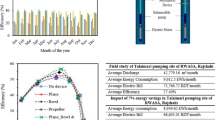Abstract
Distributed pumping system demonstrates advantages in energy saving and hydraulic stability. This paper analyzes the mechanism of the distributed pumping system for energy saving and studies the characteristics of energy consumption under the design condition, as well as the flow regulation operations in the conventional pumping system and in the distributed pumping systems. The experimental results show that the distributed pumping system saves about 12 % energy under the design condition compared with the conventional pumping system and around 39 % energy when the mixing ratio (μ) is unity for the conventional pumping system. Also, the dimensionless flow rate is adopted as an index to evaluate the hydraulic stability of the distributed pumping system. The experimental results also show that positioning the datum point of zero pressure at the central part of the main pipes, equipping the equalizer pipes among the pumps, and reducing the pressure losses in the main pipes efficiently improve the hydraulic stability of the distributed pumping system.

Similar content being viewed by others
Abbreviations
- Q h :
-
Return water flow in the secondary pipework (m3/h)
- Q 1g :
-
Supply water flow in the primary pipework (m3/h)
- g:
-
Gravity acceleration (m/s2)
- Q :
-
Total flow rate (m3/h)
- H 0 :
-
Pressure loss of critical path (mH2O)
- N 0 :
-
Power output of pump (kW)
- N 1 :
-
Total pump power output (kW)
- H 1 :
-
Pressure loss of second critical path (mH2O)
- Q 0 :
-
Flow rate of critical path (m3/h)
- H :
-
Pump head (m)
- N :
-
Pump power output (kW)
- \({Q_{i}^{\ast}}\) :
-
Ratio of the actual flow rate
- Q i :
-
Design flow rate
- X i :
-
Dimensionless flow rate
- \({\overline{X_{i}}}\) :
-
A mean of dimensionless flow rate
- \({\overline{\bar{{X}}}}\) :
-
Relative stability of the entire system
- μ :
-
Mixing ratio
- β :
-
Energy-saving ratio
- K :
-
Total number of user branches
- ρ :
-
Density of water (kg/m3)
References
Ahmad A.: Energy simulation for a typical house built with different types of masonry building materials. Arab. J. Sci. Eng. 29, 113–126 (2004)
Bhimwal M.K.: Photochemical conversion of solar energy into electrical energy in an Eosin–Mannose system. Arab. J. Sci. Eng. 37, 19–26 (2012)
Azarpour A., Suhaimi S., Zahedi G., Bahadori A.: A review on the drawbacks of renewable energy as a promising energy source of the future. Arab. J. Sci. Eng. 38, 317–328 (2013)
Ma Z., Wang S.: An optimal control strategy for complex building central chilled water systems for practical and real-time applications. Build. Environ. 44, 1188–1198 (2009)
Sun J.: Optimal supervisory control of a central chilled water plant with heuristic search sequential quadratic programming. Eng. Optimiz. 42, 863–885 (2010)
Rishel J.B.: Distributed pumping for chilled and hot water systems. ASHRAE T. 100, 1521–1527 (1994)
Avery G.: Improving the efficiency of chilled water plants. ASHRAE J. 43, 14–18 (2001)
Risel J.B.: Control of variable-speed pumps on hot- and chilled-water systems. ASHRAE T. 97, 746–750 (1991)
Tillack L., Rishel J.B.: Proper control of HVAC variable speed pumps. ASHRAE J. 40, 41–47 (1998)
ASHRAE Handbook: HVAC systems and equipment, American Society of Heating. Refrigerating and Air-conditioning Engineers, Atlanta, USA (2000)
Hegberg R.A.: Why consider a primary–secondary hydronic pumping system?. ASHRAE T. 100, 1516–1520 (1994)
Hyman L.B., Bockmiller F.R.: Primary chilled water loop retrofit. ASHRAE J. 42, 60–64 (2000)
Potratz S.J.: Design considerations of a central variable flow chilled water plant. ASHRAE T. 97, 759–762 (1991)
ASHRAE Handbook: HVAC systems and equipment, American Society of Heating. Refrigerating and Air-conditioning Engineers, Atlanta, USA (2005)
Bahnfleth W.P., Peyer E.: Energy use and economic comparison of chilled-water pumping systems alternatives. ASHRAE T. 112, 198–208 (2006)
Tirmizi S.A., Gandhidasan P., Zubair S.M.: Performance analysis of a chilled water system with various pumping schemes. Appl. Energy 100, 238–248 (2012)
Hartman T.: All-variable speed centrifugal chiller plants. ASHRAE J. 43, 43–52 (2001)
Wang S., Ma Z.: Supervisory and optimal control of building HVAC systems: a review. HVAC&R Res. 14, 3–32 (2008)
Ma Z., Wang S.: Supervisory and optimal control of central chiller plants using simplified adaptive models and genetic algorithm. Appl. Energy 88, 198–211 (2011)
Yu F.W., Chan K.T.: Environmental performance and economic analysis of all-variable speed chiller systems with load-based speed control. Appl. Therm. Eng. 29, 1721–1729 (2009)
Luther K.R.: Variable volume pumping fundamentals. HPAC 70, 6 (1998)
Rishel J.B.: Piping chillers to variable volume chilled water systems. ASHRAE J. 36, 43–45 (1994)
Avery G.: Controlling chillers in variable flow systems. ASHRAE J. 40, 42–45 (1998)
McQuay, Chiller Plant Design: Application Guide AG 31-003-1 2002. McQuay Int. (2002)
Taylor S.T.: Degrading chilled water plant delta-T: causes and mitigation. ASHRAE T. 108, 641–653 (2002)
Chan C.W.H.: Optimizing chiller plant control logic. ASHRAE J. 48, 39–42 (2006)
Ma Z., Wang S.: Enhancing the performance of large primary–secondary chilled water systems by using bypass check valve. Energy 36, 268–276 (2011)
Moffat, R.J.: Describing the uncertainties in experimental results. Exp. Therm. Fluid Sci. 1, 3–17 (1998)
Author information
Authors and Affiliations
Corresponding author
Rights and permissions
About this article
Cite this article
Wang, Z., Zheng, Y., Wang, F. et al. Experimental Study on Energy Consumption and Hydraulic Stability for Distributed Pumping System. Arab J Sci Eng 39, 6883–6894 (2014). https://doi.org/10.1007/s13369-014-1265-6
Received:
Accepted:
Published:
Issue Date:
DOI: https://doi.org/10.1007/s13369-014-1265-6




